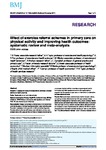Effect of exercise referral schemes in primary care on physical activity and improving health outcomes: systematic review and meta-analysis
| dc.contributor.author | Pavey, TG | |
| dc.contributor.author | Taylor, Adrian | |
| dc.contributor.author | Fox, KR | |
| dc.contributor.author | Hillsdon, M | |
| dc.contributor.author | Anokye, N | |
| dc.contributor.author | Campbell, JL | |
| dc.contributor.author | Foster, C | |
| dc.contributor.author | Green, C | |
| dc.contributor.author | Moxham, T | |
| dc.contributor.author | Mutrie, N | |
| dc.contributor.author | Searle, J | |
| dc.contributor.author | Trueman, P | |
| dc.contributor.author | Taylor, RS | |
| dc.date.accessioned | 2018-08-13T13:13:18Z | |
| dc.date.available | 2018-08-13T13:13:18Z | |
| dc.date.issued | 2011-11-04 | |
| dc.identifier.issn | 0959-8138 | |
| dc.identifier.issn | 1468-5833 | |
| dc.identifier.other | ARTN d6462 | |
| dc.identifier.uri | http://hdl.handle.net/10026.1/12053 | |
| dc.description.abstract |
OBJECTIVE: To assess the impact of exercise referral schemes on physical activity and health outcomes. Design Systematic review and meta-analysis. DATA SOURCES: Medline, Embase, PsycINFO, Cochrane Library, ISI Web of Science, SPORTDiscus, and ongoing trial registries up to October 2009. We also checked study references. Study selection Design: randomised controlled trials or non-randomised controlled (cluster or individual) studies published in peer review journals. POPULATION: sedentary individuals with or without medical diagnosis. Exercise referral schemes defined as: clear referrals by primary care professionals to third party service providers to increase physical activity or exercise, physical activity or exercise programmes tailored to individuals, and initial assessment and monitoring throughout programmes. Comparators: usual care, no intervention, or alternative exercise referral schemes. RESULTS: Eight randomised controlled trials met the inclusion criteria, comparing exercise referral schemes with usual care (six trials), alternative physical activity intervention (two), and an exercise referral scheme plus a self determination theory intervention (one). Compared with usual care, follow-up data for exercise referral schemes showed an increased number of participants who achieved 90-150 minutes of physical activity of at least moderate intensity per week (pooled relative risk 1.16, 95% confidence intervals 1.03 to 1.30) and a reduced level of depression (pooled standardised mean difference -0.82, -1.28 to -0.35). Evidence of a between group difference in physical activity of moderate or vigorous intensity or in other health outcomes was inconsistent at follow-up. We did not find any difference in outcomes between exercise referral schemes and the other two comparator groups. None of the included trials separately reported outcomes in individuals with specific medical diagnoses. Substantial heterogeneity in the quality and nature of the exercise referral schemes across studies might have contributed to the inconsistency in outcome findings. Conclusions Considerable uncertainty remains as to the effectiveness of exercise referral schemes for increasing physical activity, fitness, or health indicators, or whether they are an efficient use of resources for sedentary people with or without a medical diagnosis. | |
| dc.format.extent | d6462-d6462 | |
| dc.format.medium | Electronic | |
| dc.language | en | |
| dc.language.iso | eng | |
| dc.publisher | BMJ | |
| dc.subject | Cost-Benefit Analysis | |
| dc.subject | Exercise | |
| dc.subject | Health Status Indicators | |
| dc.subject | Humans | |
| dc.subject | Motor Activity | |
| dc.subject | Physical Fitness | |
| dc.subject | Primary Health Care | |
| dc.subject | Quality of Life | |
| dc.subject | Referral and Consultation | |
| dc.title | Effect of exercise referral schemes in primary care on physical activity and improving health outcomes: systematic review and meta-analysis | |
| dc.type | journal-article | |
| dc.type | Journal Article | |
| dc.type | Meta-Analysis | |
| dc.type | Research Support, Non-U.S. Gov't | |
| dc.type | Review | |
| dc.type | Systematic Review | |
| plymouth.author-url | https://www.webofscience.com/api/gateway?GWVersion=2&SrcApp=PARTNER_APP&SrcAuth=LinksAMR&KeyUT=WOS:000208865700001&DestLinkType=FullRecord&DestApp=ALL_WOS&UsrCustomerID=11bb513d99f797142bcfeffcc58ea008 | |
| plymouth.issue | nov04 2 | |
| plymouth.volume | 343 | |
| plymouth.publication-status | Published | |
| plymouth.journal | BMJ | |
| dc.identifier.doi | 10.1136/bmj.d6462 | |
| plymouth.organisational-group | /Plymouth | |
| plymouth.organisational-group | /Plymouth/Faculty of Health | |
| plymouth.organisational-group | /Plymouth/Faculty of Health/Peninsula Medical School | |
| plymouth.organisational-group | /Plymouth/REF 2021 Researchers by UoA | |
| plymouth.organisational-group | /Plymouth/REF 2021 Researchers by UoA/UoA03 Allied Health Professions, Dentistry, Nursing and Pharmacy | |
| plymouth.organisational-group | /Plymouth/Research Groups | |
| plymouth.organisational-group | /Plymouth/Research Groups/FoH - Community and Primary Care | |
| plymouth.organisational-group | /Plymouth/Research Groups/Institute of Health and Community | |
| plymouth.organisational-group | /Plymouth/Research Groups/Institute of Translational and Stratified Medicine (ITSMED) | |
| plymouth.organisational-group | /Plymouth/Research Groups/Institute of Translational and Stratified Medicine (ITSMED)/CCT&PS | |
| plymouth.organisational-group | /Plymouth/Research Groups/Plymouth Institute of Health and Care Research (PIHR) | |
| plymouth.organisational-group | /Plymouth/Users by role | |
| plymouth.organisational-group | /Plymouth/Users by role/Academics | |
| plymouth.organisational-group | /Plymouth/Users by role/Researchers in ResearchFish submission | |
| dc.publisher.place | England | |
| dc.identifier.eissn | 1468-5833 | |
| dc.rights.embargoperiod | Not known | |
| rioxxterms.versionofrecord | 10.1136/bmj.d6462 | |
| rioxxterms.licenseref.uri | http://www.rioxx.net/licenses/all-rights-reserved | |
| rioxxterms.type | Journal Article/Review |


